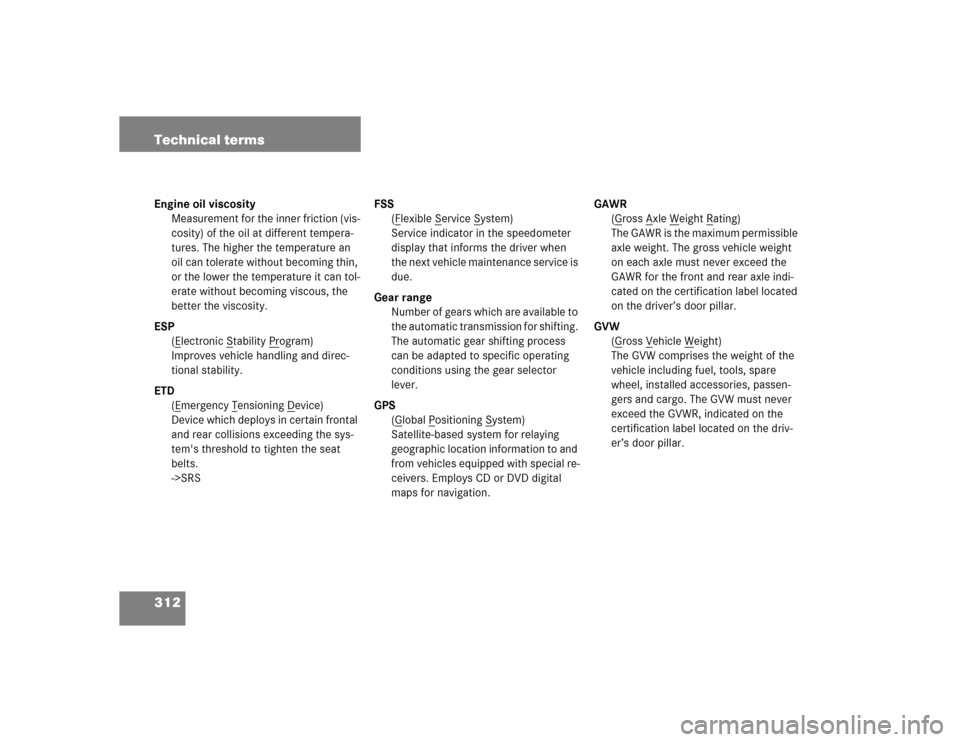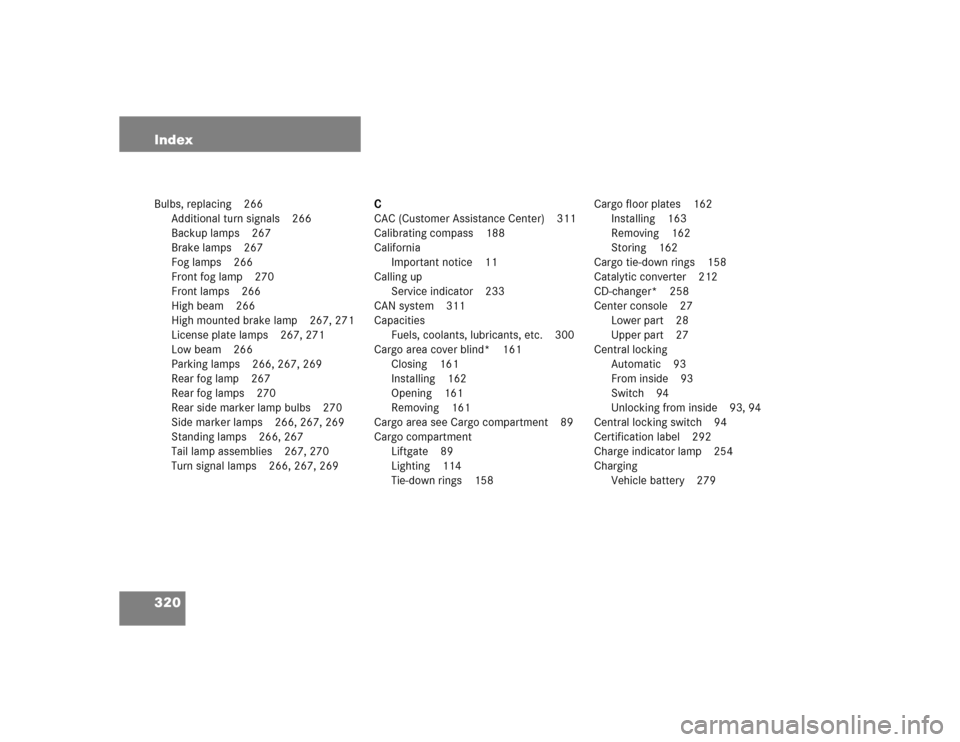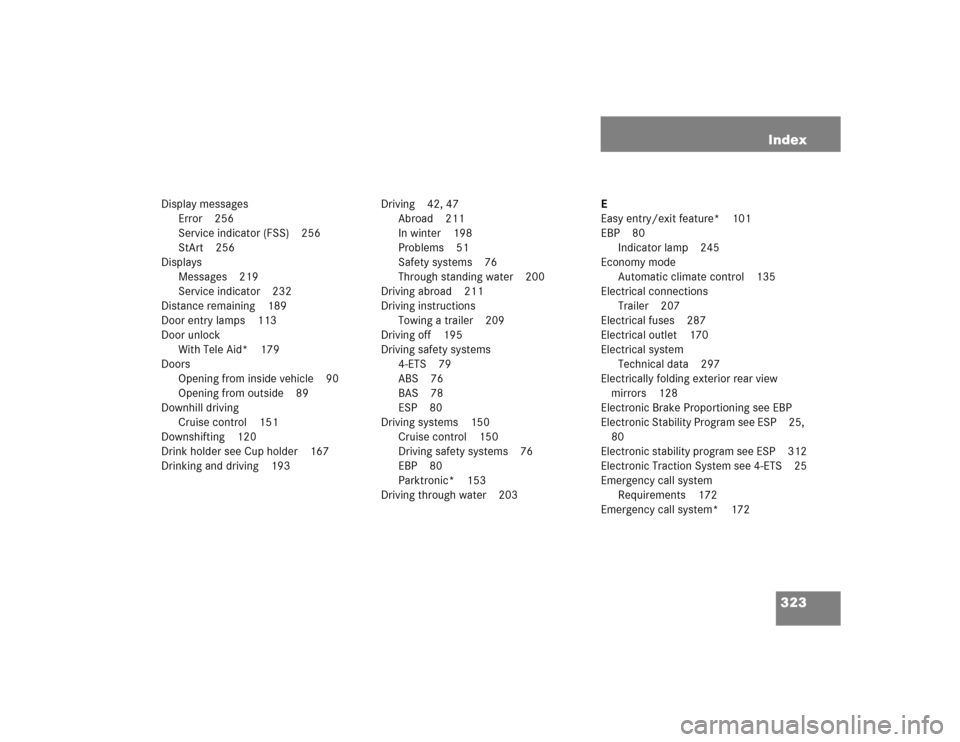Page 233 of 344

233 Operation
Maintenance
Service term exceeded
If you have exceeded the suggested ser-
vice term:�
the9 or ½symbol appears in
the display2 for 30 seconds and a
signal sounds after switching on the
ignition.
�
it is preceded by a “–” (minus symbol).
The Mercedes-Benz Light Truck Center will
reset the service indicator following a com-
pleted service.
Calling up the service indicator�
Within one second press knob1
twice.
The FSS display will appear for
ten seconds.
Resetting the service indicator
In the event that the service on your vehi-
cle is not carried out by an authorized
Mercedes-Benz Light Truck Center, you
can reset the service indicator yourself.�
Switch ignition on and immediately
press knob1 twice within
one second.
The present status for days or distance
is displayed.
�
Within ten seconds turn the key in
steering lock to position0 (
�page 33).
�
Press and hold knob1 while switch-
ing the ignition on.
The present status for days or distance
is displayed once more.
�
Continue to hold knob1.
After approximately ten seconds a sig-
nal sounds, and the display shows
10 000 miles (Canada: 15 000 km) for
approximately ten seconds.
�
Release knob1.
iIf the service indicator was inadvertent-
ly reset, have a Mercedes-Benz Light
Truck Center correct it.
Only reset if the proper service has
been performed. Resetting the system
without performing the proper service
as called for by the FSS will cause the
FSS to incorrectly determine the next
service interval which will result in en-
gine damage not covered by the
Mercedes-Benz Limited Warranty.
If the battery is disconnected, the days
of disconnection will not be included in
the count shown by the service indica-
tor. To arrive at the true service dead-
line, you will need to subtract these
days from the days shown in the ser-
vice indicator.
Do not confuse the service indicator
with the engine oil level indicator:.
Page 248 of 344

248 Practical hintsWhat to do if …Problem
Possible cause
Suggested solution
?
The yellow “CHECK ENGINE”
malfunction indicator lamp
comes on while driving.
There is a malfunction of:�
The fuel management system
�
The ignition system
�
The emission control system
�
Systems which affect emissions
Such malfunctions may result in excessive
emissions values and may switch the engine
to its limp-home (emergency operation)
mode.
�
Have the vehicle checked as soon as
possible by an authorized
Mercedes-Benz Light Truck Center.
An on-board diagnostic connector is
used by the service station to link the
vehicle to the shop diagnostics sys-
tem. It allows the accurate identifica-
tion of system malfunctions through
the readout of diagnostic trouble
codes. It is located in the front left
area of the footwell next to the park-
ing brake pedal.
The fuel cap is not closed tightly.
Check the fuel cap (
�page 214).
Your fuel tank is empty.
�
After refuelling start the engine three
or four times in succession.
The limp-home mode is canceled. You do
not need to have your vehicle checked.
Page 254 of 344
254 Practical hintsWhat to do if …Problem
Possible cause
Suggested solution
#
The red charge indicator lamp
comes on when the engine is
running.
The battery is no longer charging.
Possible causes:�
alternator malfunctioning
�
broken poly-V-belt
�
Stop immediately and check the
poly-V-belt.
If it is broken
�
Do not continue to drive, before the
poly-V-belt is replaced.
Notify an authorized Mercedes-Benz
Light Truck Center.
2
The yellow brake indicator lamp
comes on during braking or after
starting the engine.
The brake pads are worn down.
�
Have the system checked at an autho-
rized Mercedes-Benz Light Truck
Center.
!Brake pad thickness must be visually
checked by a qualified technician at the
intervals specified in the Service book-
let.
Page 256 of 344
256 Practical hintsWhat to do if …Additional indicators in the speedome-ter displayDisplay
Possible cause
Suggested solution
9
Perform minor service (A) (
�page 232).
�
Visit an authorized Mercedes-Benz
Light Truck Center to perform service.
´
Perform major service (B) (
�page 232).
�
Visit an authorized Mercedes-Benz
Light Truck Center to perform service.
Á
î
The
StArt
message comes on in
addition to the
Error
message.
The immobilizer is not operational.
�
Contact an authorized
Mercedes-Benz Light Truck Center or
call 1-800-FOR-MERCedes (in the
USA), or 1-800-387-0100 (in Cana-
da).
Page 311 of 344

311 Technical terms
ABS
(A
ntilock B
rake S
ystem)
Prevents the wheels from locking up
during braking so that the vehicle can
continue to be steered.
BabySmart
TM airbag deactivation
system
This system detects if a special system
compatible child restraint seat is in-
stalled on the front passenger seat. The
system will automatically deactivate
the passenger front airbag when such a
seat is properly installed (indicator
lamp7 in the instrument cluster
lights up). See your authorized
Mercedes-Benz Light Truck Center for
availability.
BabySmartTM compatible child seats
Special restraint system for children.
The sensor system for the passenger
seat prevents deployment of the pas-
senger front airbag if a BabySmart
TM
compatible child seat is installed.BAS
(B
rake A
ssist S
ystem)
System for potentially reducing braking
distances in emergency braking situa-
tions. The system is activated when it
senses an emergency based on how
fast the brake is applied.
Bi-Xenon headlamps*
Headlamps which use an electric arc as
the light source and produce a more in-
tense light than filament headlamps.
Bi-Xenon headlamps produce low
beam and high beam.
CAC
(C
ustomer A
ssistance C
enter)
Mercedes-Benz customer service cen-
ter, which can help you with any ques-
tions about your vehicle and provide
assistance in the event of a break-
down.CAN system
(C
ontroller A
rea N
etwork)
Data bus network serving to control ve-
hicle functions such as door locking or
windshield wiping.
Cockpit
All instruments, switches, buttons and
indicator / warning lamps in the pas-
senger compartment needed for vehi-
cle operation and monitoring.
Cruise control
Driving convenience system for auto-
matically maintaining the vehicle speed
set by the driver.
Engine number
The number set by the manufacturer
and placed on the cylinder block to
uniquely identify each engine pro-
duced.
Page 312 of 344

312 Technical termsEngine oil viscosity
Measurement for the inner friction (vis-
cosity) of the oil at different tempera-
tures. The higher the temperature an
oil can tolerate without becoming thin,
or the lower the temperature it can tol-
erate without becoming viscous, the
better the viscosity.
ESP
(E
lectronic S
tability Pr
ogram)
Improves vehicle handling and direc-
tional stability.
ETD
(E
mergency T
ensioning D
evice)
Device which deploys in certain frontal
and rear collisions exceeding the sys-
tem's threshold to tighten the seat
belts.
->SRSFSS
(F
lexible S
ervice S
ystem)
Service indicator in the speedometer
display that informs the driver when
the next vehicle maintenance service is
due.
Gear range
Number of gears which are available to
the automatic transmission for shifting.
The automatic gear shifting process
can be adapted to specific operating
conditions using the gear selector
lever.
GPS
(G
lobal P
ositioning S
ystem)
Satellite-based system for relaying
geographic location information to and
from vehicles equipped with special re-
ceivers. Employs CD or DVD digital
maps for navigation.GAWR
(G
ross A
xle W
eight R
ating)
The GAWR is the maximum permissible
axle weight. The gross vehicle weight
on each axle must never exceed the
GAWR for the front and rear axle indi-
cated on the certification label located
on the driver’s door pillar.
GVW
(G
ross V
ehicle W
eight)
The GVW comprises the weight of the
vehicle including fuel, tools, spare
wheel, installed accessories, passen-
gers and cargo. The GVW must never
exceed the GVWR, indicated on the
certification label located on the driv-
er’s door pillar.
Page 320 of 344

320 IndexBulbs, replacing 266
Additional turn signals 266
Backup lamps 267
Brake lamps 267
Fog lamps 266
Front fog lamp 270
Front lamps 266
High beam 266
High mounted brake lamp 267, 271
License plate lamps 267, 271
Low beam 266
Parking lamps 266, 267, 269
Rear fog lamp 267
Rear fog lamps 270
Rear side marker lamp bulbs 270
Side marker lamps 266, 267, 269
Standing lamps 266, 267
Tail lamp assemblies 267, 270
Turn signal lamps 266, 267, 269C
CAC (Customer Assistance Center) 311
Calibrating compass 188
California
Important notice 11
Calling up
Service indicator 233
CAN system 311
Capacities
Fuels, coolants, lubricants, etc. 300
Cargo area cover blind* 161
Closing 161
Installing 162
Opening 161
Removing 161
Cargo area see Cargo compartment 89
Cargo compartment
Liftgate 89
Lighting 114
Tie-down rings 158Cargo floor plates 162
Installing 163
Removing 162
Storing 162
Cargo tie-down rings 158
Catalytic converter 212
CD-changer* 258
Center console 27
Lower part 28
Upper part 27
Central locking
Automatic 93
From inside 93
Switch 94
Unlocking from inside 93, 94
Central locking switch 94
Certification label 292
Charge indicator lamp 254
Charging
Vehicle battery 279
Page 323 of 344

323 Index
Display messages
Error 256
Service indicator (FSS) 256
StArt 256
Displays
Messages 219
Service indicator 232
Distance remaining 189
Door entry lamps 113
Door unlock
With Tele Aid* 179
Doors
Opening from inside vehicle 90
Opening from outside 89
Downhill driving
Cruise control 151
Downshifting 120
Drink holder see Cup holder 167
Drinking and driving 193Driving 42, 47
Abroad 211
In winter 198
Problems 51
Safety systems 76
Through standing water 200
Driving abroad 211
Driving instructions
Towing a trailer 209
Driving off 195
Driving safety systems
4-ETS 79
ABS 76
BAS 78
ESP 80
Driving systems 150
Cruise control 150
Driving safety systems 76
EBP 80
Parktronic* 153
Driving through water 203E
Easy entry/exit feature* 101
EBP 80
Indicator lamp 245
Economy mode
Automatic climate control 135
Electrical connections
Trailer 207
Electrical fuses 287
Electrical outlet 170
Electrical system
Technical data 297
Electrically folding exterior rear view
mirrors 128
Electronic Brake Proportioning see EBP
Electronic Stability Program see ESP 25,
80
Electronic stability program see ESP 312
Electronic Traction System see 4-ETS 25
Emergency call system
Requirements 172
Emergency call system* 172